The Opportunity of “The Magic Quarter Second”
 In the book My
Stroke of Insight, brain scientist Jill Bolte Taylor explains that the
natural life span of an emotion—the average time it takes for it to move
through the nervous system and body—is only a minute and a half, a mere ninety
seconds. After that, we need thoughts to keep the emotion rolling. So, if we
wonder why we lock into painful emotional states like anxiety, depression, or
rage, we need look no further than our own endless stream of inner dialogue.
In the book My
Stroke of Insight, brain scientist Jill Bolte Taylor explains that the
natural life span of an emotion—the average time it takes for it to move
through the nervous system and body—is only a minute and a half, a mere ninety
seconds. After that, we need thoughts to keep the emotion rolling. So, if we
wonder why we lock into painful emotional states like anxiety, depression, or
rage, we need look no further than our own endless stream of inner dialogue.Modern neuroscience has discovered a fundamental truth: Neurons that fire together, wire together. When we rehearse a looping set of thoughts and emotions, we create deeply grooved patterns of emotional reactivity. This means that the more you think and rethink about certain experiences, the stronger the memory and the more easily activated the related feelings become.
For example, if a young girl asks her father for help and he either ignores her or reacts with irritation, the emotional pain of rejection may become linked with any number of thoughts or beliefs: “I’m not loved,” “I’m not worth helping,” “I’m weak for wanting help,” “It’s dangerous to ask for help,” “He’s bad. I hate him.”
The more the child gets this response from either parent—or even imagines getting this response—the more the impulse to ask for help becomes paired with the belief that she will be refused and the accompanying feelings (fear or hurt, anger or shame). Years later, she may hesitate to ask for help at all. Or, if she does ask, and the other person so much as pauses or looks distracted, the old feelings instantly take over: She downplays her needs, apologizes, or becomes enraged.
Unless we learn to recognize and interrupt our compulsive thinking, these ingrained emotional and behavioral patterns continue to strengthen over time. Fortunately, it’s possible to break out of this patterning.
Researcher Benjamin Libet discovered that the part of the brain responsible for movement activates a quarter-second before we become aware of our intention to move. There is then another quarter-second before the movement begins. What does this mean? First, it casts an interesting light on what we call “free will”—before we make a conscious decision, our brain has already set the gears in motion! But secondly, it offers us an opportunity.
Say you’ve been obsessing about having a cigarette. During the space between impulse (“I need to smoke a cigarette”) and action (reaching for the pack), there is room for choice. Author Tara Bennett-Goleman named this space “the magic quarter-second.” Mindfulness enables us to take advantage of it.
By catching our thoughts in the magic
quarter-second, we’re able to act from a wiser place, interrupting the circling
of compulsive thinking that fuels anxiety and other painful emotions. For
instance, if our child asks us to play a game and we automatically think “I’m
too busy,” we might pause and choose to spend some time with her. If we’ve been
caught up in composing an angry e-mail, we might pause and decide not to press
the send button.
The Buddha taught that to be free—not identified
with or possessed by thoughts or feelings—we need to investigate each and every
part of our experience with an intimate and mindful attention. The first step
is pausing, making use of the magic quarter second, and the second, choosing to
be present with our moment –to- moment experience. We need to recognize the fear-based thoughts
and the tension in our bodies with an accepting, curious and kind attention.
The fruit of this presence is a capacity to release habitual reactivity,
respond to our life circumstances with a wise heart and step out of the grip of
oppressive emotions. Adapted from True Refuge (Bantam, Jan., 2013)


